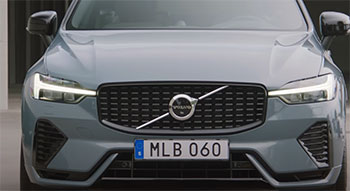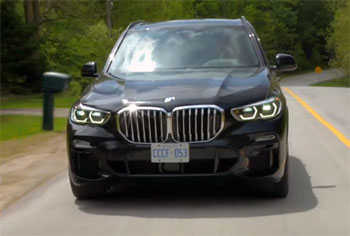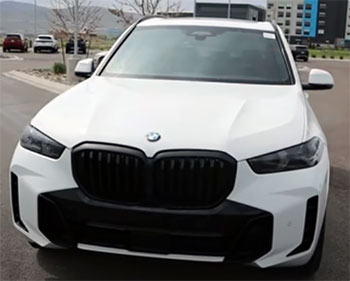I’ve always been drawn to the allure of luxury SUVs—those sleek, powerful machines that promise both comfort and adventure. When it came time to choose my next ride, I found myself torn between the 2025 BMW X5 and the 2025 Volvo XC60.
Both are giants in the midsize luxury SUV segment, blending style, performance, and tech in their own unique ways. In this article, I’ll share my journey of comparing these two, breaking down their pros and cons from a driver’s perspective to help you decide which one suits your lifestyle best.
Comparison Table: BMW X5 vs. Volvo XC60
| Feature | BMW X5 (2025) | Volvo XC60 (2025) |
|---|---|---|
| Starting MSRP | $68,775 | $48,345 |
| Engine (Base) | 3.0L Turbo Inline-6, 375 hp | 2.0L Turbo Inline-4, 247 hp |
| 0-60 mph (Base) | 5.3 seconds | 6.6 seconds |
| Fuel Economy (City/Hwy) | 23/27 MPG | 23/30 MPG |
| Cargo Space (Max) | 72.3 cu. ft. | 63.3 cu. ft. |
| Front Legroom | 39.8 in. | 41.5 in. |
| Second-Row Legroom | 37.4 in. | 38.0 in. |
| Safety Rating (IIHS) | Top Safety Pick (2024) | Top Safety Pick (2023) |
| Infotainment | 14.9-inch iDrive touchscreen | 12-inch Google built-in touchscreen |
| Standard AWD | Optional | Standard |
| Plug-in Hybrid Option | xDrive50e (483 hp, 39 miles electric) | Recharge T8 (455 hp, 35 miles electric) |
My Journey with the BMW X5 and Volvo XC60
As someone who loves the open road but also needs a practical family hauler, I wanted a vehicle that could balance thrilling performance with everyday usability. The BMW X5 and Volvo XC60 kept popping up in my research, each with its own fanbase raving about luxury, safety, or driving dynamics.
To figure out which one was right for me, I took both for test drives, pored over specs, and even chatted with owners on forums like Reddit and SwedeSpeed. Here’s what I found, broken down into the key aspects that matter most to me—and likely to you.
Performance: Power and Precision

Let’s start with the engines, because who doesn’t love a car that responds when you press the pedal?
The BMW X5’s base model, the xDrive40i, boasts a 3.0-liter turbocharged inline-six pumping out 375 horsepower.
It’s a beast, hitting 0-60 mph in 5.3 seconds. On my test drive, the X5 felt like it was glued to the road, with sharp steering and a suspension that soaked up bumps while keeping things sporty.
The eight-speed automatic transmission shifted so smoothly I barely noticed it working. If you opt for the M60i, you get a 4.4-liter V8 hybrid with 523 horsepower—pure adrenaline for those who crave it.
The Volvo XC60, on the other hand, starts with a 2.0-liter turbocharged four-cylinder (B5 AWD) delivering 247 horsepower. It’s no slouch, but the 0-60 mph time of 6.6 seconds felt a bit leisurely compared to the X5. The B6 AWD bumps power to 295 horsepower, closing the gap with a 5.9-second sprint.
What surprised me was the XC60 Recharge T8, a plug-in hybrid with 455 horsepower that rockets to 60 mph in 4.5 seconds. I took one for a spin, and the instant torque from the electric motor was a game-changer, especially in city traffic.
Pros of BMW X5 Performance:
- More powerful base engine (375 hp vs. 247 hp).
- Quicker acceleration across most trims.
- Sporty handling that feels like a performance sedan.
Cons of BMW X5 Performance:
- AWD isn’t standard; you’ll pay extra for xDrive.
- Higher trims like the M60i are pricey and overkill for daily driving.
Pros of Volvo XC60 Performance:
- Standard AWD across all trims, great for all-weather driving.
- Recharge T8’s 455 hp outpaces most X5 trims.
- Smoother ride for relaxed cruising.
Cons of Volvo XC60 Performance:
- Base engine feels underpowered compared to X5.
- Less engaging handling for spirited drivers.
For me, the X5’s athleticism was a thrill, but the XC60’s Recharge T8 gave me that eco-friendly punch I didn’t expect. If you’re after raw power, the X5 wins; if you want efficiency with a side of speed, the XC60’s plug-in hybrid is tempting.
Fuel Economy: Balancing Power and Efficiency

With gas prices fluctuating, fuel economy matters. The BMW X5’s base model gets 23 MPG city and 27 MPG highway, which is decent for a powerful SUV. The xDrive50e plug-in hybrid offers 39 miles of electric range and 50 MPGe, making it a solid choice for short commutes.
I loved the idea of zipping around town on electric power, but the X5’s fuel economy drops when the gas engine kicks in.
The Volvo XC60 edges out slightly with 23 MPG city and 30 MPG highway on the B5 AWD.
The Recharge T8 is the star here, with 63 MPGe and 35 miles of electric range. During my test drive, I managed a 20-mile round trip on electric power alone, which felt like a small victory for my wallet and the planet. The XC60’s mild-hybrid system also smooths out stop-and-go traffic, sipping less fuel than the X5 in urban settings.
Pros of BMW X5 Fuel Economy:
- Plug-in hybrid offers decent electric range.
- Competitive MPG for a performance-focused SUV.
Cons of BMW X5 Fuel Economy:
- Slightly worse highway MPG than XC60.
- Premium fuel recommended, adding to costs.
Pros of Volvo XC60 Fuel Economy:
- Better highway MPG (30 vs. 27).
- Recharge T8’s 63 MPGe is a standout for efficiency.
Cons of Volvo XC60 Fuel Economy:
- Base model’s city MPG matches X5 but doesn’t feel as powerful.
- Electric range slightly shorter than X5’s PHEV.
The XC60’s efficiency won me over for daily driving, but the X5’s hybrid setup is no slouch if you want a balance of power and economy.
Interior: Comfort Meets Technology

Stepping inside these SUVs is like entering two different worlds.
The BMW X5’s cabin screams modern luxury with its 14.9-inch curved touchscreen running the latest iDrive system.
It’s intuitive, responsive, and packed with features like wireless Apple CarPlay and Android Auto.
The seats are plush, with heated front seats standard, but I noticed the front legroom (39.8 inches) felt a bit tight for my 6-foot frame.
The second row, with 37.4 inches of legroom, was adequate but not class-leading.
My only gripe was the glossy woodgrain trim—gorgeous but a glare magnet in bright sunlight.
The Volvo XC60’s interior, by contrast, feels like a Scandinavian spa. The 12-inch Google built-in touchscreen is sleek and user-friendly, though it took me a minute to get used to the voice controls.
The front seats offer 41.5 inches of legroom, and the second row’s 38 inches felt noticeably roomier. The XC60’s seats are some of the most comfortable I’ve ever sat in, with optional massage functions that made me dread leaving the car. The minimalist design, with wood and chrome accents, exudes warmth and elegance.
Pros of BMW X5 Interior:
- Cutting-edge iDrive system with large, vibrant display.
- Premium materials and build quality.
- Customizable ambient lighting adds flair.
Cons of BMW X5 Interior:
- Less front and second-row legroom than XC60.
- Glossy trim can cause glare issues.
Pros of Volvo XC60 Interior:
- Spacious and ergonomic cabin design.
- Ultra-comfortable seats with massage option.
- Google built-in infotainment is modern and intuitive.
Cons of Volvo XC60 Interior:
- Touchscreen can be slow to respond at times.
- Fewer customization options than X5’s iDrive.
The XC60’s cabin felt more inviting for long drives, but the X5’s tech-heavy cockpit appealed to my gadget-loving side. Your choice might depend on whether you prioritize space or tech dazzle.
Cargo and Practicality: Family-Friendly or Not?
As a parent, cargo space is a big deal. The BMW X5 offers 33.9 cubic feet behind the second row and 72.3 cubic feet with the seats folded. I easily fit a stroller, groceries, and sports gear, but the lack of a third-row option in 2025 models disappointed me. The X5’s power tailgate and low load floor made loading a breeze, though.
The Volvo XC60 has 17.1 cubic feet behind the second row and 63.3 cubic feet max. It’s less spacious than the X5 but still handled my family’s weekend haul. The XC60’s built-in booster seats are a genius touch for parents, offering kids independence without sacrificing safety. The rear seat storage, with tablet mounts and USB-C ports, kept my kids entertained on long trips.
Pros of BMW X5 Cargo:
- Larger cargo capacity (72.3 cu. ft. max).
- Easy-to-use power tailgate.
Cons of BMW X5 Cargo:
- No third-row option for larger families.
- Less second-row storage than XC60.
Pros of Volvo XC60 Cargo:
- Family-friendly features like booster seats and tablet mounts.
- Decent cargo space for a midsize SUV.
Cons of Volvo XC60 Cargo:
- Smaller cargo capacity than X5.
- Tighter space behind second row.
The X5 wins for raw cargo space, but the XC60’s thoughtful family features made it a strong contender for my needs.
Safety: Keeping You and Your Loved Ones Secure
Safety is non-negotiable, especially with kids in the car. The BMW X5 earned a 2024 IIHS Top Safety Pick, excelling in crash tests and pedestrian detection. Standard features include blind-spot monitoring, lane departure warning, and adaptive cruise control. The X5’s driver alert monitor was a lifesaver during a late-night drive, nudging me when I started to drift.
The Volvo XC60, with its legendary safety reputation, scored a 2023 IIHS Top Safety Pick. Its standard suite includes a Blind Spot Information System, Lane Keeping Aid, and a 360-degree camera that made parking a breeze. The XC60’s 5-star Global NCAP rating reassured me, and its safety heritage—think seatbelts and crumple zones—gave it an edge emotionally.
Pros of BMW X5 Safety:
- Top Safety Pick rating with strong crash test performance.
- Comprehensive standard safety features.
Cons of BMW X5 Safety:
- Some advanced features require higher trims or packages.
Pros of Volvo XC60 Safety:
- Stellar safety legacy and 5-star NCAP rating.
- Standard AWD enhances traction in bad weather.
Cons of Volvo XC60 Safety:
- Slightly older Top Safety Pick rating (2023 vs. 2024).
- Some safety tech feels less refined than X5’s.
The XC60’s safety pedigree is hard to beat, but the X5’s modern tech holds its own. Both are safe bets for families.
Read More: My Thoughts On Acura MDX Vs. Volvo XC90
Price and Value: What’s Your Money Getting You?
Price was a big factor in my decision. The BMW X5 starts at $68,775, a steep jump from the Volvo XC60’s $48,345. The X5’s higher trims, like the M60i ($90,075), push it into near-six-figure territory. You get premium performance and tech, but options like xDrive and advanced driver aids add up fast.
The XC60’s base B5 AWD is a bargain by comparison, and even the Recharge T8 ($59,195) undercuts the X5’s plug-in hybrid. The XC60’s standard features, like AWD and a panoramic moonroof, make it feel like a better value. I appreciated not having to pay extra for essentials.
Pros of BMW X5 Value:
- Premium brand cachet and performance.
- Resale value tends to hold strong.
Cons of BMW X5 Value:
- Higher starting price and option costs.
- Premium fuel and maintenance can be pricey.
Pros of Volvo XC60 Value:
- Lower starting price with more standard features.
- Plug-in hybrid is more affordable than X5’s.
Cons of Volvo XC60 Value:
- Resale value not as strong as BMW.
- Higher trims still expensive for a four-cylinder.
The XC60 offers better bang for your buck, but the X5’s prestige and power justify the cost for some.
Driving Experience: The Joy of the Journey
Driving the X5 felt like conducting a symphony—every turn was precise, every acceleration purposeful. The adaptive suspension let me switch between comfort and sport modes, making it versatile for city streets or winding roads. But the X5’s size (9.7 inches longer, 4 inches wider than the XC60) made it feel bulky in tight parking lots.
The XC60, by contrast, drove like a smaller, nimbler SUV. Its steering was light but responsive, and the cabin’s quietness made long drives serene. The Recharge T8’s electric mode was a revelation in traffic, but the base model’s softer handling didn’t thrill me like the X5 did.
Pros of BMW X5 Driving:
- Dynamic, engaging handling.
- Versatile suspension for varied driving styles.
Cons of BMW X5 Driving:
- Larger size can feel cumbersome in tight spaces.
- Sporty ride may be too firm for some.
Pros of Volvo XC60 Driving:
- Nimble and easy to maneuver.
- Quiet, comfortable ride, especially in electric mode.
Cons of Volvo XC60 Driving:
- Less engaging for performance enthusiasts.
- Base model lacks the X5’s dynamism.
If you love driving, the X5 is your pick. If comfort and ease are priorities, the XC60 shines.
Reliability: Will It Leave You Stranded?
Reliability was a concern, given horror stories about luxury SUV maintenance. J.D. Power’s 2023 Initial Quality Study ranks BMW higher than Volvo, with 58 fewer problems per 100 vehicles. Consumer Reports also rates the X5 xDrive50e 32 points higher than the XC60 T8 for reliability. However, my chats with owners on Reddit revealed mixed experiences—some X5s had electrical gremlins, while XC60s faced infotainment glitches.
Pros of BMW X5 Reliability:
- Higher J.D. Power and Consumer Reports ratings.
- Improved reliability in recent G05 generation.
Cons of BMW X5 Reliability:
- Past models had electrical and suspension issues.
- Maintenance costs can be high.
Pros of Volvo XC60 Reliability:
- Generally reliable for a luxury SUV.
- Fewer major issues reported in recent models.
Cons of Volvo XC60 Reliability:
- Infotainment system can be buggy.
- Some SPA platform models had early teething problems.
The X5 has a slight edge in data, but both require diligent maintenance to avoid headaches.
Read More: My Thoughts On Acura MDX Vs. Lexus GX
Frequently Asked Questions (FAQ)
BMW ranks higher in J.D. Power’s 2023 Initial Quality Study with 58 fewer problems per 100 vehicles than Volvo. Consumer Reports also rates the X5 above the XC60. However, both brands have had issues, so maintenance is key.
The X5 offers superior performance and tech but lacks a third row. The XC90 is more spacious (85.7 cu. ft. cargo) and family-friendly with standard AWD. Choose the X5 for driving fun, the XC90 for space.
The Volvo XC90 is the closest match to the X5 in size and luxury, offering three rows and similar features. The XC60 is smaller but competes in the midsize luxury segment.
The XC60 has a less powerful base engine, smaller cargo space (63.3 cu. ft. max), occasional infotainment glitches, and lower resale value compared to the X5.
My Verdict: Which SUV Won My Heart?
After weeks of test drives and number-crunching, I leaned toward the Volvo XC60. Its lower price, standard AWD, and family-friendly features like booster seats won me over as a practical parent. The Recharge T8’s efficiency and power were icing on the cake. That said, the BMW X5’s thrilling performance and tech-heavy cabin were hard to resist. If I were a single driver craving a sporty ride, the X5 would’ve been my choice.
Ultimately, your decision depends on what you value most. Want luxury and performance? The X5 delivers. Prioritize value, safety, and comfort? The XC60 is your match. Test drive both, and let your heart (and budget) guide you.

